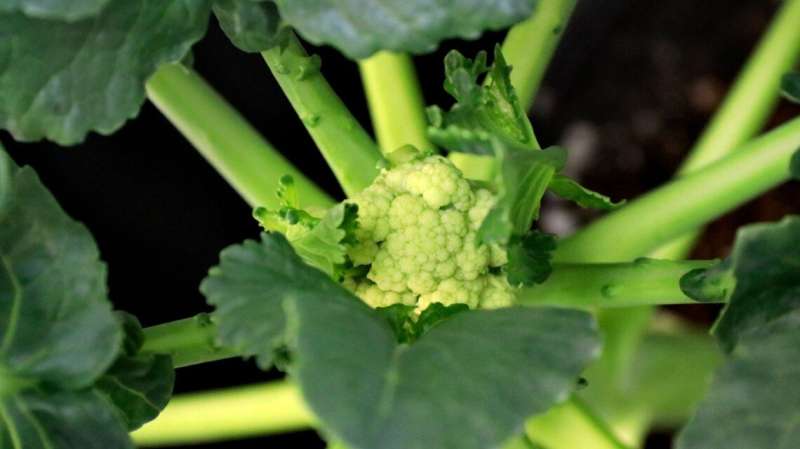This article has been reviewed according to Science X's editorial process and policies. Editors have highlighted the following attributes while ensuring the content's credibility:
fact-checked
trusted source
proofread
Broccoli looks more like cauliflower in warmer world

As seasoned gardeners know, broccoli heads don't develop properly and can resemble cauliflower when grown in higher temperatures.
A new study identifies the genetic underpinnings for why broccoli heads become abnormal when it's hot, providing insight into effects of climate-induced warming for all crops and pointing the way for breeding heat-resistant new varieties.
Broccoli grows best when planted in cool early spring or late summer, into fall. The researchers found that while broccoli grows normally at average temperatures of 61 degrees Fahrenheit, its crowns begin to deform at 72 degrees F and it forms dense cauliflower-like heads (called curds) at 82 degrees F.
The researchers then applied 5-azacytidine, a chemical known to inhibit a process called DNA methylation, where a methyl group—a small molecule—gets added to DNA. Methylation is one mechanism for turning genes on and off; in this case it suppresses a cluster of genes required for normal broccoli head production. When 5-azacytidine was administered, normal broccoli heads grew even at 82 degrees F, suggesting that methylation was behind the abnormal growth in the presence of heat.
"Once we understand the mechanism better, we should be able to devise ways to develop a new biotechnology, a molecular genetics approach to suppress DNA methylation, in order to breed crops to grow in much warmer temperatures and in wider regions," said Susheng Gan, professor in the School of Integrative Plant Science Plant Biology Section, in the College of Agriculture and Life Sciences, and a co-corresponding author of the paper published Dec. 22 in the journal Molecular Horticulture.
Liping Chen, a professor of vegetable science at Zhejiang University in Hangzhou, China, is the other corresponding author.
Warming temperatures impact all aspects of growth and development in plants. Flower development is especially complex and sensitive to temperatures, with heat reducing the quality and yield of vegetables such as broccoli where the complete flower head—including stems, stalks, leaves and flowers—is eaten. Though more study is needed, Gan believes that at higher temperatures, DNA methylation of genes involved in floral development may be conserved across all crops.
In the study, the researchers profiled broccoli plants (Brassica oleracea) using whole-genome sequencing technologies that identified the plant's methylome—where in the genome methylation occurred—and its transcriptome—which identifies which genes are turned on. They found that abnormal flower development in broccoli was regulated by sets of floral development cessation-associated genes (FCGs). At 61 degrees F, broccoli heads (its floral bud) developed normally. At 82 degrees F and to a lesser extent at 72 degrees F, methylation of genetic elements that turned on FCGs were suppressed.
When grown at warmer temperatures, floral development becomes restricted to earlier stages of development. So, at 72 degrees F, broccoli buds are restricted to a stage where they look like a cross between a broccoli head and cauliflower curd; and at 82 degrees, they are even further undeveloped, and resemble a cauliflower-like curd.
Future studies will examine the mechanism behind DNA methylation of FCGs at high temperatures.
More information: Zilei Yao et al, Warming-induced changes of broccoli head to cauliflower-like curd in Brassica oleracea are regulated by DNA methylation as revealed by methylome and transcriptome co-profiling, Molecular Horticulture (2022). DOI: 10.1186/s43897-022-00047-8
Provided by Cornell University


















